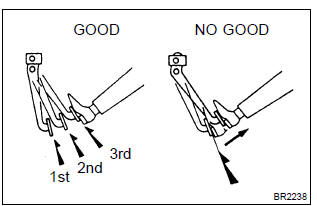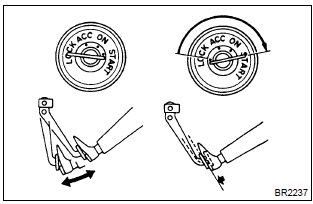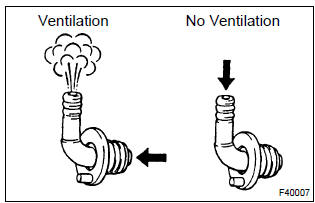Toyota Corolla (E120): On–vehicle inspection
1. Inspect brake booster

- Airtightness check.
- Start the engine and stop it after 1 or 2 minutes. Depress
the brake pedal several times slowly.
Hint
: if the pedal goes down farthest at the 1st time, but gradually rises after the 2nd or 3rd time, the booster is airtight.
- Depress the brake pedal while the engine is running,
and stop the engine with the pedal depressed.
Hint
: if there is no change in the pedal reserve distance after holding the pedal for 30 seconds, the booster is airtight.

- Operating check.
- Depress the brake pedal several times with the ignition switch off and check that there is no change in the pedal reserve distance.
- Depress the brake pedal and start the engine.
Hint
: if the pedal goes down slightly, operation is normal.
2. Inspect vacuum check valve
- check vacuum check valve.
- Slide the clip and disconnect the vacuum hose.
- Remove the vacuum check valve.

- Check that there is ventilation from the booster to engine, and no ventilation from the engine to the booster.
- If any fault is found, replace the vacuum check valve.
Other materials:
Update contacts from phone
Operation methods differ between PBAP compatible and PBAP incompatible but OPP
compatible Bluetooth® phones.
If your cellular phone is neither PBAP nor OPP compatible, the contacts cannot
be transferred.
■ For PBAP Compatible Bluetooth® Phones
1 Select “Update Contacts from Phone” ...
Circuit description
The shift solenoid valve sl is turned ”on” and ”off” by signals from the ecm
in order to control the hydraulic
pressure operation, the lock–up relay valve, which then the controls operation
of the lock–up clutch.
Fail safe function:
if the ecm detects a malfunction, it turns the ...
Using the radio
Radio operation
Select “AM” or “FM” to begin listening to the radio.
1 Power
2 Volume
3 Station selectors
4 Adjust frequency or select an item
5 AM/FM mode button
6 Scan for receivable stations
7 Seek a frequency
Setting station presets
1Search for a desired station by turning
...


